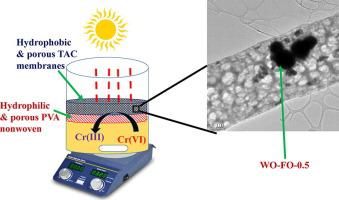Journal of Industrial and Engineering Chemistry ( IF 5.9 ) Pub Date : 2021-06-30 , DOI: 10.1016/j.jiec.2021.06.025 Kebena Gebeyehu Motora , Chang-Mou Wu , Saba Naseem

|
For environmental scientists, developing an efficient, stable, and recyclable solar light photocatalyst is a challenging issue. Even though powder photocatalysts have excellent photocatalytic activity, their recyclability and reusability is a noteworthy problem. Therefore, it is very crucial to develop a new photocatalysis system that possesses efficient photocatalytic activity, excellent stability, and ease of recyclability, and is free of secondary pollution. Herein, a solar light active WO2.72/Fe3O4 nanocomposite photocatalyst was immobilized in hydrophobic porous recycled triacetate cellulose (rTAC) to solve the reusability problem and was electrospun on hydrophilic nonwoven polyvinyl alcohol (PVA) to fabricate a self-floatable recyclable Janus membrane. TAC possesses very important properties such as high moisture permeability and high light transmittance, which helps all the light irradiated to be utilized by the photocatalyst and hydrophobicity, which increases the ease of floating. The recyclable Janus membrane was purposefully designed so that the contaminated water can be attracted by PVA due to its hydrophilicity and pass to porous rTAC, where the pollutant and the photocatalyst come into contact and photocatalysis takes place, while the hydrophobicity of the rTAC makes the Janus membrane float on the surface of polluted water. The photocatalytic property of the synthesized recyclable Janus membrane was studied for the photodegradation of rhodamine B (Rh B) and methylene blue (MB) as well as the photoreduction of the carcinogenic pollutant Cr(VI) under solar light irradiation. The recyclable Janus membrane presented an outstanding photocatalytic property for the photodegradation of Rh B and MB dyes and the photoreduction of Cr(VI). It also displayed excellent cyclic stability and ease of recyclability for both organic and inorganic pollutants after multiple experimental cycles. The Janus membrane also presented better photocatalytic activity than previously reported photocatalysts for MB photodegradation. Therefore, the developed interfacial photocatalysis system and the recyclable Janus membrane are promising candidates for environmental remediation under solar light irradiation. This study paves the way for the design of an environmentally friendly, effective, and stable photocatalyst for wastewater treatment.
中文翻译:

Janus膜固定的磁性可回收自漂浮太阳能光驱动WO2.72/Fe3O4纳米复合材料用于无机和有机污染物的光催化
对于环境科学家来说,开发一种高效、稳定且可回收的太阳能光催化剂是一个具有挑战性的问题。尽管粉末光催化剂具有优异的光催化活性,但其可回收性和可重复使用性是一个值得注意的问题。因此,开发一种具有高效光催化活性、优异稳定性、易回收性、无二次污染的新型光催化体系至关重要。在此,太阳光活性WO 2.72 /Fe 3 O 4纳米复合光催化剂固定在疏水性多孔回收三醋酸纤维素(rTAC)中以解决可重复使用性问题,并在亲水性非织造聚乙烯醇(PVA)上进行静电纺丝以制造自漂浮可回收Janus膜。TAC具有非常重要的特性,如高透湿性和高透光率,有助于光触媒利用所有照射的光和疏水性,增加漂浮的容易度。可回收的 Janus 膜的设计目的是使受污染的水由于 PVA 的亲水性而被 PVA 吸引并传递到多孔 rTAC,在那里污染物和光催化剂接触并发生光催化作用,而 rTAC 的疏水性使 Janus膜漂浮在污水表面。研究了合成的可回收 Janus 膜的光催化性能,用于光降解罗丹明 B (Rh B) 和亚甲蓝 (MB) 以及在太阳光照射下光还原致癌污染物 Cr(VI)。可回收的 Janus 膜对 Rh B 和 MB 染料的光降解和 Cr(VI) 的光还原具有出色的光催化性能。在多次实验循环后,它还对有机和无机污染物显示出优异的循环稳定性和易于回收利用。Janus 膜还表现出比先前报道的用于 MB 光降解的光催化剂更好的光催化活性。所以,开发的界面光催化系统和可回收的 Janus 膜是太阳光照射下环境修复的有希望的候选者。该研究为设计一种环保、有效且稳定的废水处理光催化剂铺平了道路。











































 京公网安备 11010802027423号
京公网安备 11010802027423号